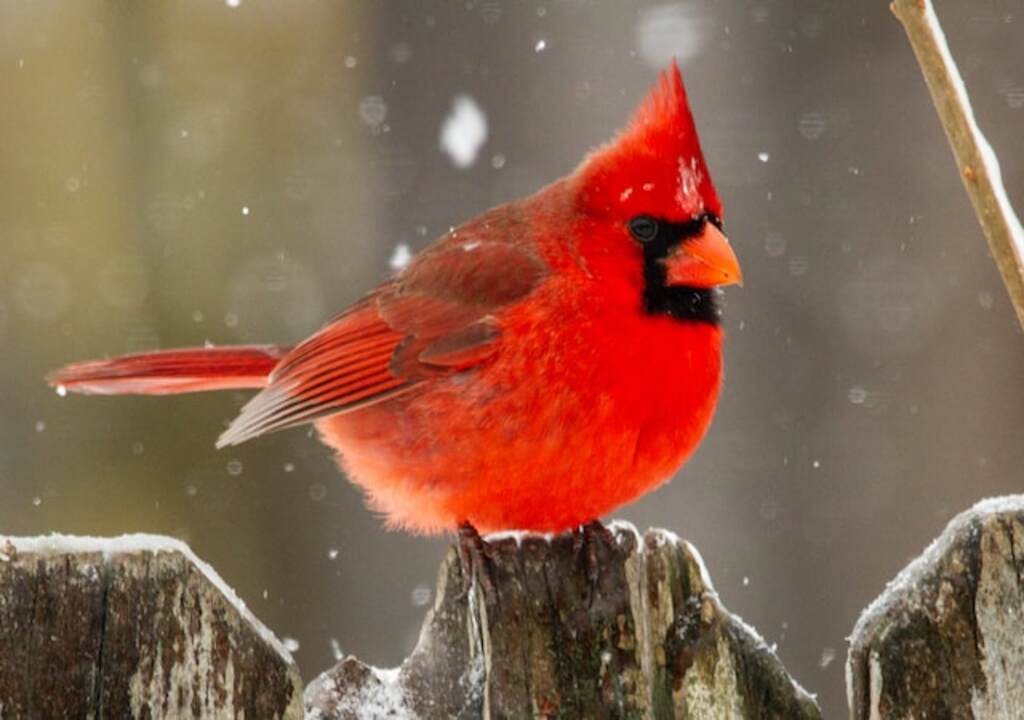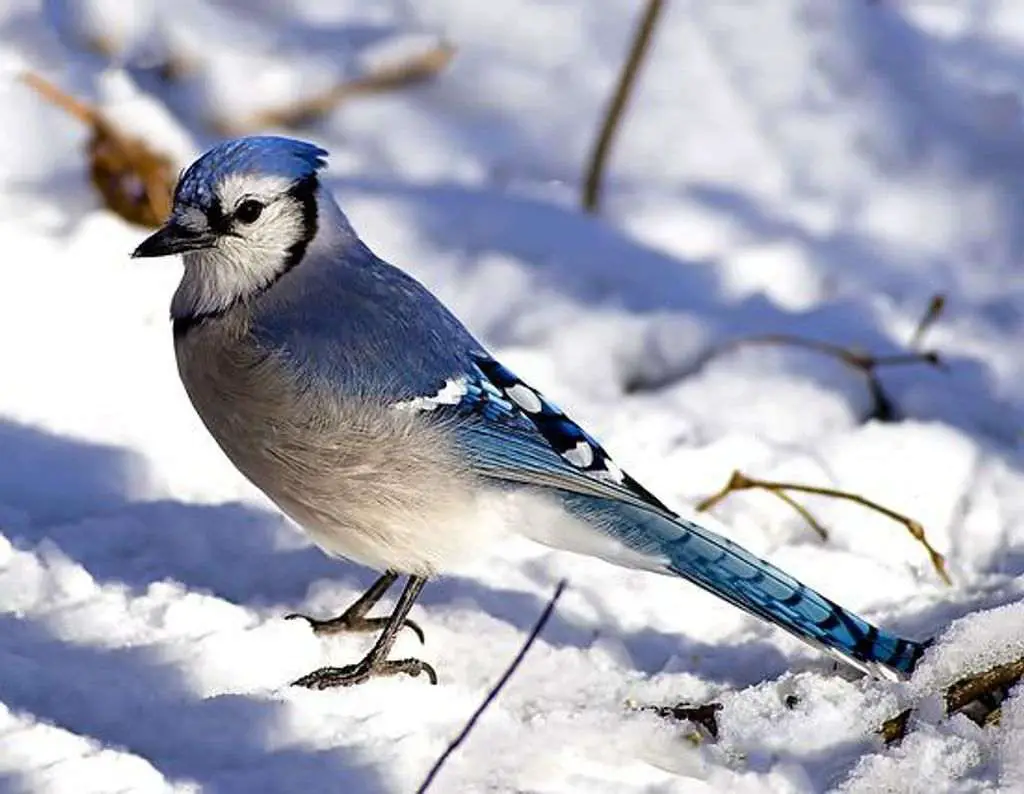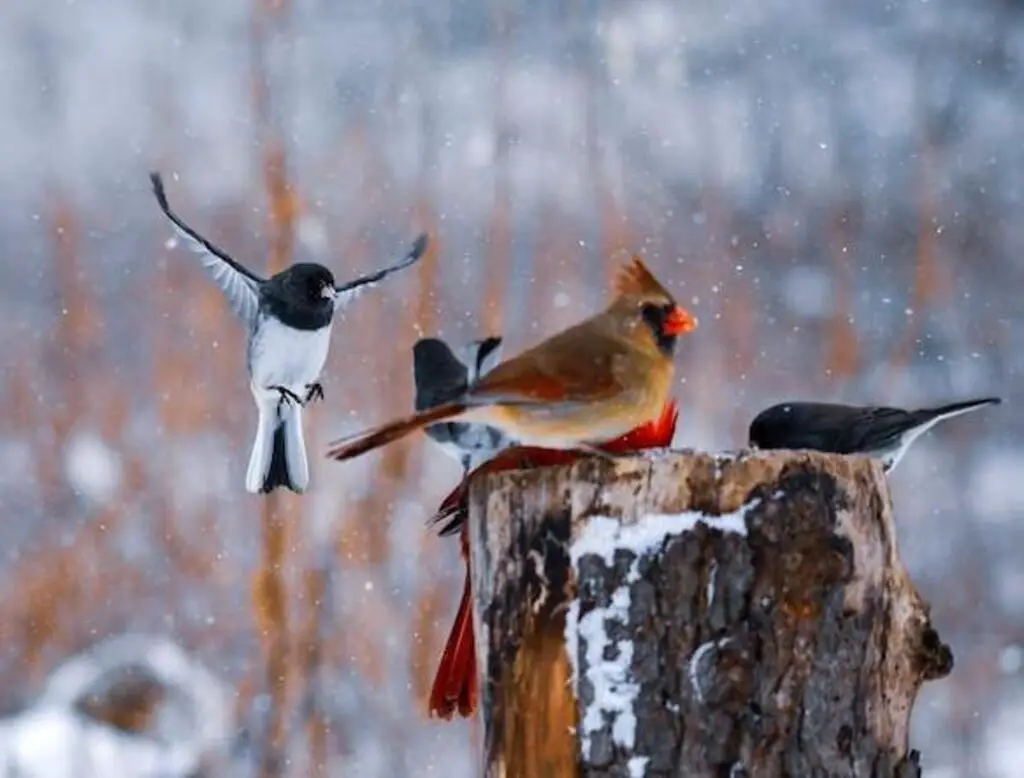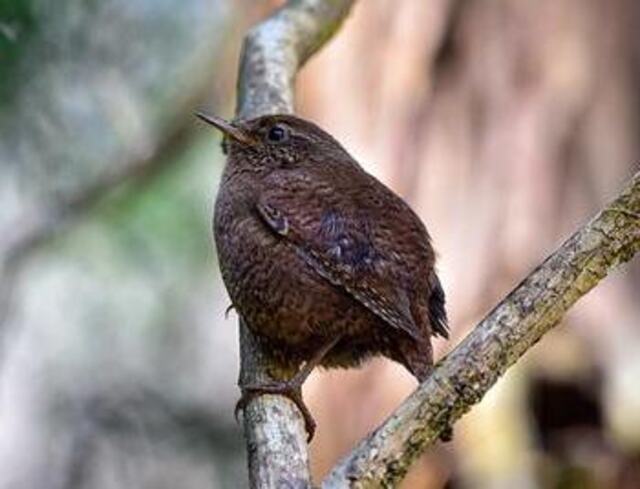Winter can be a challenging time for birds, with limited food and water sources available. However, with a few simple steps, you can create a bird-friendly environment in your yard that attracts a diverse range of winter birds.
In this guide, we will provide expert tips and guidance on how to attract birds to your yard in winter. We will focus on creating a bird-friendly environment and providing necessary food and shelter for winter birds.
Table of Contents
- 1 Key Takeaways:
- 2 How to Attract Birds to your Yard in Winter?
- 3 Creating a Winter Bird-Friendly Yard
- 4 Winter Bird Feeders and Food
- 5 Choosing the Right Bird Feed
- 6 Providing Water Sources in Winter
- 7 Creating Winter Shelter for Birds
- 8 The Role of Native Plants in Winter Bird Attraction
- 9 Birdwatching and Winter Bird Identification
- 10 Overcoming Common Challenges
- 11 Conclusion
- 12 FAQs: How to Attract Birds to your Yard in Winter?
- 12.1 How can I attract birds to my yard during the winter season?
- 12.2 What types of bird feeders and food are suitable for winter birds?
- 12.3 How do I choose the right bird feed for winter birds?
- 12.4 Do birds need water sources in winter?
- 12.5 How can I create winter shelter for birds?
- 12.6 What is the role of native plants in attracting winter birds?
- 12.7 How can I observe and identify winter birds?
- 12.8 What are some common challenges when attracting winter birds?
- 13 Author
Key Takeaways:
- Creating a bird-friendly yard in winter requires providing suitable food, water, and shelter for winter birds.
- Native plants play a crucial role in creating a suitable habitat for winter birds.
- Offering a variety of food options can attract a diverse range of bird species.
How to Attract Birds to your Yard in Winter?
Attracting birds to your yard in winter can be a challenge, but there are several ways to make your space more inviting to our feathered friends. One of the best ways to attract birds in winter is to provide a consistent food source, such as birdseed, suet, or fruit.
You can also offer fresh water in a bird bath or heated water dish, as many birds struggle to find liquid water during the colder months. Planting native trees and shrubs that produce berries or seeds can also provide a natural food source and shelter for birds.
Finally, consider adding bird houses or nesting boxes to your yard, as some species may use them for shelter during the winter months. With these tips, you can create a welcoming habitat for birds in your yard all year round.
Creating a Winter Bird-Friendly Yard
Winter can be a challenging time for birds, with limited food and shelter available. However, you can create a bird-friendly yard to attract winter birds and provide them with the necessary support they need to survive the cold winter months.
Shelter
Providing shelter for birds is essential, particularly during the winter months when extreme weather conditions can make it challenging for them to find a secure place to rest. Birdhouses and roosting boxes are great options for winter shelter, but make sure they are installed in a safe location away from predators and harsh winds. Also, regularly inspect and maintain these shelters to ensure they remain safe and secure.
Water Sources
Birds require water for drinking and bathing, even during the winter months. Consider providing a heated bird bath or add a bird bath heater to your existing bird baths to prevent the water from freezing. Remember to keep the water source clean and change the water regularly to prevent the spread of diseases.
Planting
Native plants offer birds a natural source of food and shelter. Consider adding native plants to your yard that provide year-round interest, such as trees, shrubs, and grasses. These plants also offer a natural source of food for birds, with berries and seeds available during the winter months.
Food
Winter birds require a high-fat diet to maintain their energy levels during the cold months. Offer a variety of high-fat foods such as black oil sunflower seeds, suet, and peanuts. Consider offering a mixed seed blend to attract a diverse range of bird species. Also, make sure the feeding station is easily accessible and clean the feeder regularly to prevent the spread of diseases.
By providing adequate shelter, water, planting, and food sources, you can create a bird-friendly yard that attracts winter birds and provides them with the necessary support they need to survive the challenging winter months.
Winter Bird Feeders and Food
In the colder months, food can be scarce for birds, making a bird feeder a welcome addition to your yard. There are a variety of bird feeders available, and it’s important to choose the right one and the right food to attract the birds you want to see.
Types of Bird Feeders
There are several types of bird feeders you can choose from, including:
- Hopper feeders – hold a large amount of seed and have a platform for birds to perch on.
- Suet feeders – hold blocks of suet, which is a high-energy food made from fat and other ingredients.
- Tube feeders – hold smaller amounts of seed and have small openings that dispense the seed as birds perch on them.
- Window feeders – attach to the outside of a window and provide an up-close view of feeding birds.
Choosing the Right Bird Food
It’s important to choose bird food that is appropriate for the species of birds you want to attract. Here are some common bird foods:
- Black oil sunflower seeds – a favorite of many bird species and high in fat and protein.
- Thistle seed – also known as nyjer, this small seed is a favorite of finches and other small birds.
- Suet – a high-energy food made from animal fat and often mixed with other ingredients, like nuts or fruit.
- Corn – attracts larger birds like crows, jays, and pigeons.
Feeder Placement and Maintenance
When placing bird feeders, it’s important to consider the safety of the birds. Place feeders in a location that is visible from the house, but also provides cover for the birds to retreat to if necessary. Keep feeders clean to prevent the spread of disease, and refill them regularly to ensure a steady food supply for the birds.
Choosing the Right Bird Feed
Offering the right kind of bird feed is crucial for attracting winter birds to your yard. Here are some suggestions for the best types of bird feed:
| Food Type | Best For |
|---|---|
| Black oil sunflower seed | Attracts a wide variety of birds, including finches, cardinals, and woodpeckers |
| Suet | Provides necessary fat for birds in cold weather, attracting woodpeckers, nuthatches, and chickadees |
| Peanuts | Attracts jays, woodpeckers, and chickadees |
| Safflower seed | Discourages squirrels and grackles, while attracting cardinals, finches, and chickadees |
It’s important to offer a variety of food options, as different birds have different nutritional needs. Additionally, make sure to keep your bird feeders clean and well-stocked to ensure a steady food supply throughout winter.
Backyard Bird Information Tool
Use this tool to learn more about common backyard birds. Select a species from the drop-down menu to see information about the proper feeder and food type, as well as some interesting facts about the bird.
| Feeder | |
|---|---|
| Food | |
| Facts |
Providing Water Sources in Winter
During the winter months, birds require water for drinking and bathing, just like they do during other seasons. However, it can be challenging to provide water sources that don’t freeze, and ensuring birds can access them easily.
You can use a bird bath heater to prevent the water in the bird bath from freezing, which will help birds get the water they need to survive. Another option is to use a heated bird bath that keeps water liquid even in sub-zero temperatures. These two options will go a long way in ensuring birds have access to water even on the coldest days.
It’s important to place the water source in an easily accessible location. Birds should be able to perch near the water source and have an unobstructed view of any potential predators. Placing the water source near dense shrubs or evergreens can also provide birds with protection from harsh winter winds.
Creating Winter Shelter for Birds
Providing suitable shelter for birds during the winter is crucial to their survival. Here are some tips on how to create effective winter shelters:
Birdhouses
Birdhouses are a great way to provide shelter for birds during the winter months. Make sure to select a birdhouse that is appropriate for the species of bird you wish to attract and place it in a location that is protected from wind, rain, and snow. Clean out old nesting material before winter and consider adding extra insulation to keep birds warm.
Roosting Boxes
Roosting boxes are larger than birdhouses and can shelter multiple birds at once. They are typically placed 10–20 feet above the ground and away from predators. Adding roosting boxes to your yard can greatly increase the number of birds you attract during the winter.
Natural Materials
Using natural materials to create shelter can be a cost-effective and environmentally friendly option for attracting winter birds. Piles of leaves, branches, and brush can provide excellent cover for birds from harsh winter conditions. Consider leaving some areas of your yard undisturbed to provide a natural winter habitat for birds.
The Role of Native Plants in Winter Bird Attraction
Native plants play a crucial role in creating a suitable habitat for winter birds. They provide the necessary food and shelter that birds need to survive the colder months. Additionally, planting native species has numerous benefits for your local ecosystem.
The Benefits of Native Plants
One of the main benefits of planting native plants is that they are better adapted to local climatic conditions and require less maintenance than non-native species. They also provide habitat and food for a variety of local wildlife, including winter birds.
Native plants also play a critical role in supporting pollinators such as bees and butterflies, which are essential for the health of many ecosystems. By planting native species, you are helping to support the broader ecological community in your area.
Choosing the Right Native Plants
When selecting native plants for your yard, it’s important to choose species that are well adapted to your local climate and soil conditions. This will ensure that the plants thrive and provide the necessary food and shelter for winter birds.
Some excellent choices for winter bird-friendly native plants include:
- Serviceberry
- Winterberry
- Juniper
- Sumac
- Red Cedar
- Goldenrod
- Aster
By incorporating these and other native plants into your landscape, you create a natural habitat that will attract a variety of winter bird species. As a result, you’ll be able to birdwatch from the comfort of your own yard and contribute to the conservation of these important avian species.
Birdwatching and Winter Bird Identification
Winter birdwatching can be a wonderful way to observe birds in their natural environment and learn more about their unique behaviors during the colder months. Here are some tips for successful winter birdwatching:
- Invest in a good pair of binoculars to help you get a closer look at birds in the distance.
- Dress appropriately for the weather. Layering your clothing will help you stay warm and comfortable during extended periods outside.
- Choose a prime location for birdwatching, such as near a bird feeder or other attraction that is likely to draw a variety of winter birds.
- Be patient and observe carefully. Winter birds are often less active than their summer counterparts, so they may be more difficult to spot at times.
- Keep a journal or recording of your bird sightings. This can help you identify patterns or changes in bird populations over time.
When identifying winter birds, it’s important to pay attention to their unique features and characteristics. Look for differences in size, shape, color, and behavior to help you distinguish between species. Some common winter birds you may encounter include:
- Black-capped Chickadee: This small bird has a black cap and bib, white cheeks, and a gray back. It is a common sight at bird feeders during the winter months.
- Dark-eyed Junco: This bird has a dark-gray head and neck, white belly, and a distinctive tail that can be flicked up and down. It is often found in flocks and prefers to feed on the ground.
- American Goldfinch: This bird has bright yellow feathers in the summer, but turns more drab during the winter months. It has a distinctive conical beak and can often be found at thistle feeders.
- Downy Woodpecker: This small woodpecker has a black-and-white striped back and white belly. It often feeds on suet and is a frequent visitor to bird feeders during the winter.
- Northern Cardinal: This bird has a bright red body, black face, and distinctive crest on its head. It prefers to feed on the ground and can often be seen scratching at the snow to uncover food.
By keeping these tips in mind and staying observant, you can enjoy successful winter birdwatching and gain a deeper appreciation for the beauty of birds during the colder months.
Overcoming Common Challenges
Attracting winter birds to your yard can present some challenges. Here are some common obstacles you may face and some solutions to overcome them:
Predators
Predators such as cats, hawks, and snakes can be a danger to birds in your yard. To protect your feathered visitors, keep your bird feeders and nesting boxes out of reach of prowling cats, and place them in areas where hawks or other birds of prey won’t easily spot them. For snakes, you can install barriers around your birdhouses and nesting boxes to prevent their entry.
Unwanted Pests
Unwanted pests such as squirrels, raccoons, and rodents can be a nuisance when trying to attract birds to your yard. To discourage these pests, consider using squirrel-proof bird feeders and placing bird feeders on poles with baffles to prevent access. Also, try to avoid placing bird feeders near structures such as trees or fences that squirrels and raccoons can use to jump onto the feeder. Regular cleaning of bird feeders will also help to discourage rodents and pests.
Extreme Weather Conditions
During extreme weather conditions such as snowstorms or ice storms, access to food and water can be difficult for birds. Consider providing additional food and water sources during these times, such as heated bird baths, to ensure that birds can still access the necessary resources they need to survive. It’s also important to monitor weather forecasts and take appropriate measures to protect your birdhouses and nesting boxes from damage due to harsh conditions.
By being aware of these common challenges and taking appropriate measures to overcome them, you can create an environment that is more welcoming and safer for your winter bird visitors.
Conclusion
Attracting birds to your yard during the winter season requires careful consideration of their requirements for shelter, food, and water. By creating a bird-friendly environment with the right plants and feeders, you can enjoy the beauty of winter birds in your yard.
Providing adequate shelter is essential, and birdhouses and roosting boxes will provide important protection from the cold. Additionally, the right choice of native plants will provide excellent food sources for birds. Leaving leaves and other debris on the ground can also help provide shelter and nesting material for birds.
To fully attract winter birds to your yard, it’s essential to provide water sources that will not freeze over. This can be achieved with bird baths that have built-in heaters or by using heated water sources.
Choosing the right bird feed is also critical, and you should consider offering a wide variety of food options to attract a diverse range of bird species. Finally, winter birdwatching is a delightful activity, and by keeping a record of your sightings, you can contribute to the conservation of these important avian species.
Summary
By following the expert tips and guidance provided in this guide, you can create a bird-friendly yard that attracts a variety of winter birds. Enhancing your yard’s appeal with suitable bird feeders, water sources, shelter, and native plants will not only provide enjoyment through birdwatching but also contribute to the conservation of these important avian species.
FAQs: How to Attract Birds to your Yard in Winter?
How can I attract birds to my yard during the winter season?
To attract birds to your yard in winter, create a bird-friendly environment by providing food and shelter. Use bird feeders with appropriate winter bird food, offer water sources that won’t freeze, and provide suitable shelters such as birdhouses and roosting boxes.
What types of bird feeders and food are suitable for winter birds?
There are various types of bird feeders you can use, including hopper feeders, suet feeders, and tube feeders. For winter birds, offer foods such as black oil sunflower seeds, suet, peanuts, and nyjer seeds.
How do I choose the right bird feed for winter birds?
When choosing bird feed for winter birds, consider their nutritional needs. Offer a variety of food options to attract different bird species. Opt for high-energy foods like suet and sunflower seeds and avoid foods with additives like artificial coloring.
Do birds need water sources in winter?
Yes, birds require water for drinking and bathing, even in winter. Provide water sources that won’t freeze, such as heated birdbaths or shallow water dishes with a heating element. Keep the water source clean and refill it regularly.
How can I create winter shelter for birds?
To provide winter shelter for birds, you can use birdhouses and roosting boxes. Place them in sheltered areas, facing away from prevailing winds. Maintain the shelters by cleaning them out after each nesting season.
What is the role of native plants in attracting winter birds?
Native plants play a vital role in creating a suitable habitat for winter birds. They provide food and shelter, as well as attract insects that birds feed on. Choose native plant species that are adapted to your region’s climate and soil conditions.
How can I observe and identify winter birds?
To observe and identify winter birds, spend time birdwatching in your yard and nearby areas. Use field guides and bird identification apps to help you identify different species. Keep a birdwatching journal to record your sightings and observations.
What are some common challenges when attracting winter birds?
Common challenges when attracting winter birds include predators, unwanted pests, and extreme weather conditions. To overcome these challenges, you can implement strategies such as installing predator deterrents, using squirrel-proof feeders, and providing windbreaks for shelter.







